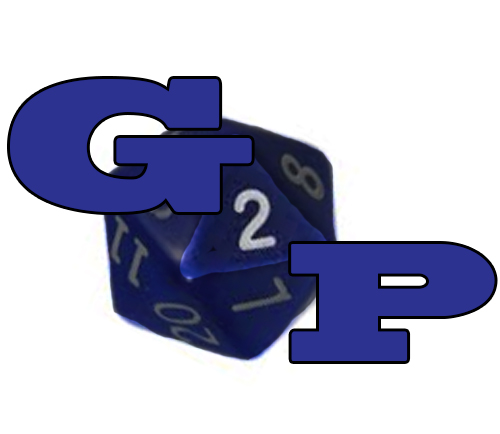
G2P (“Games 2 Play”) is a semi-regular editorial segment from GM Chris, and is devoted to showcasing the rare, the unusual, the crazy, the Indie, and (only very occasionally) the wildly popular in the tabletop RPG world. Games that you either didn’t know existed, games that you should try out as soon as you can, games that will make you laugh or hang your jaw in wonder at their amazeballs glory. In other words: games to play. This episode…
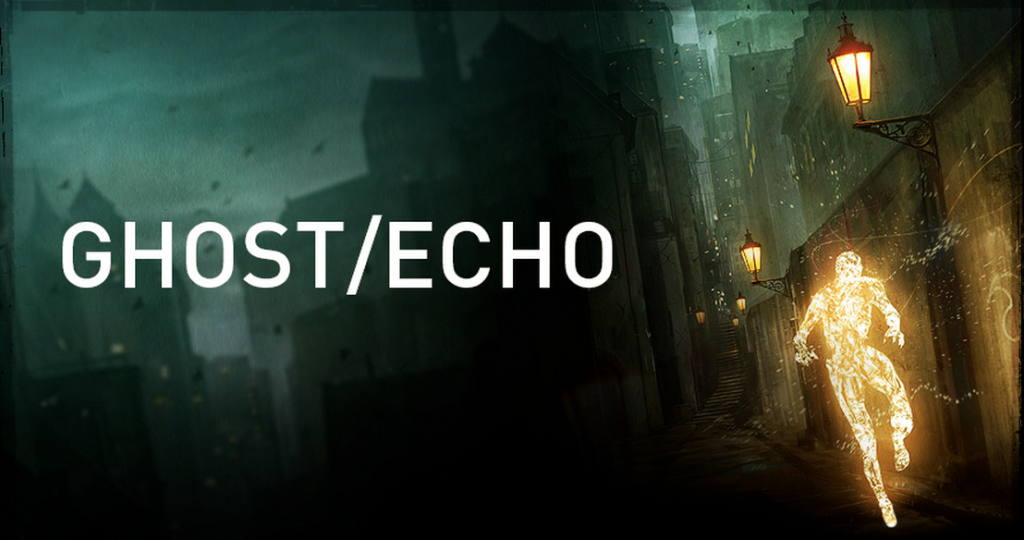
There’s just something about cyberpunk. I’m not sure what it is, but I can tell you (legitimately) that William Gibson’s Neuromancer changed my life. I must have been 14 or so when a dog-eared paperback was lent to me by a gaming buddy, after I sheepishly asked what this whole “Shadowrun game thing” he was into was all about. He tossed me the book and said, “READ.” A few weeks later, I’d voraciously devoured most of the Gibson lexicon and fell head over heels for the gritty, near-future setting of ghostly technology and the shadowy figures who operated in that world.
Many geeks and gamers share this love, and the RPG industry has consistently delivered it to us with games like the literally ORIGINAL cyberpunk RPG, Shadowrun (now in its Fifth Edition); Cyberpunk 2020; d20 Modern/Urban Arcana; Ex Machina; and lots of other outings over the decades (many mainstream systems like Savage Worlds and TORG had cyberpunk “settings”). Usually, each of these “cyberpunks” was a take on the Gibson universe – but with little additions thrown in, such as “magic” or “aliens” or “the supernatural.” This vision of an “imperfect, gritty, near-future, networked world struggling with supernatural unknowns and technology-as-magic crossovers” has become a core fandom that influences almost all the games I run, and I think I can safely say, has permanently affixed itself into our hobby – forever. Now, not all of these games have been great. Others have been epic. But there’s a legacy, here… one that makes fans like myself wary. Excited. But wary.
So when I see something new that plucks at my cyberpunk heartstrings, I approach it with an utterly excited, about-to-pee-my-pants, caution. Kind of like a puppy at the pound, bouncing around, but hiding in the corner: I’m not sure about you, but I’d still REALLY like to go home with you.
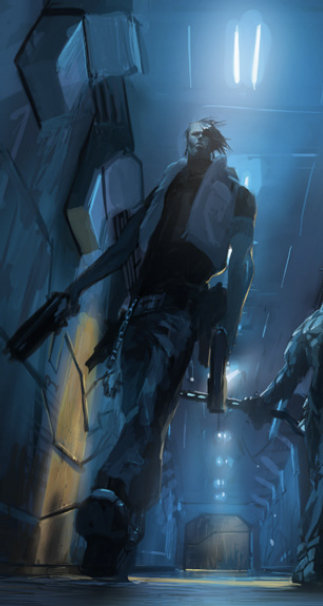
For those who know me and my RPG tastes, you know that I’m a huge fan of “pocket RPG master,” John Harper, who’s One Seven Design Production Studio has pumped out some seriously fan-loved and critically acclaimed games, such as Lasers & Feelings (which I’ve written about before in this column) and Lady Blackbird. Others know John from his work on Agon, Talislanta, Bootleggers, and World of Dungeons. But a few years back, John released a pocket RPG called GHOST/ECHO that grabbed me like a shadowrunning, cyberpunk mugger that demanded every dime of my lunch money. (And that analogy might make a lot more sense, if this game weren’t free.)
The reason GHOST/ECHO stuck with me so much wasn’t the concept (mostly because there are so many intentional blank spaces in it), or the gorgeous presentation and graphic design (stunning, though it is), or the simple-yet-unique dice resolution mechanics. I was fascinated by GHOST/ECHO simply because I had absolutely no idea what to do with it. At least, not at the time. GHOST/ECHO has the flavor of an RPG experiment, cooked up in a lab by some demented developer. Released as what Harper calls an “Oracle Game” (among others on One Seven’s site), its quick 2-page spread provides you with nothing but a starting point – and a loose one, at that – and a resolution mechanic. Everything else is left up to the players and the GM to fill in as they play.
I can’t express, as a GM, how intriguing and terrifying this was for me. The game’s unique font, design, and layout gives a group definite impressions of exactly what this world is all about; but with zero context. All sentences are structured with an “HTML Vibe,” like computer code – telling the reader that this is definitely a future world about technology. But the imagery and verbiage also imply a great deal of the supernatural. The setting of GHOST/ECHO is one of supernatural/technological entities encroaching into our world, and the heroes are those caught in middle – or perhaps, who have chosen to live and work in the middle.
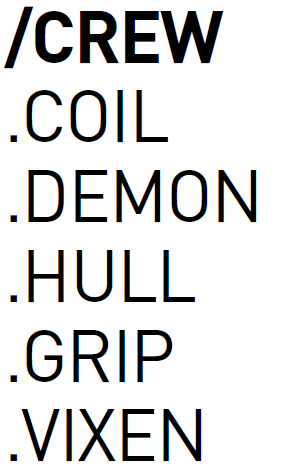 The suggested “names” of the PCs (nee /CREW) read like
The suggested “names” of the PCs (nee /CREW) read like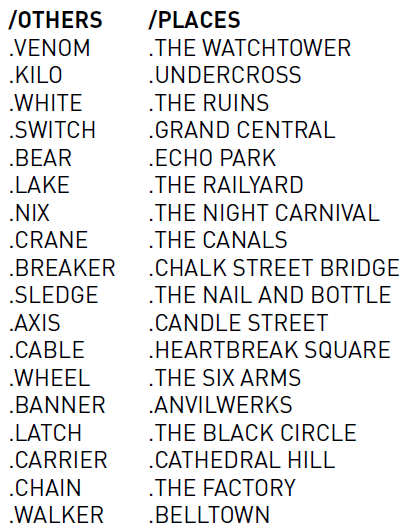 cyberpunk handles for shadowrunning middlemen. The threats, NPCs, and locales are presented the same way. Without knowing anything else about the game, I can construct in my head that “.COIL, .DEMON, and .GRIP headed to Anvilwerks to drop some Paper on a cold one after a fight with some Wraiths.” What is Anvilwerks? Who are Coil, Demon, and Grip? Do they have crazy ghost powers? What do they do? What are Wraiths? The game doesn’t tell you – and that’s the point.
cyberpunk handles for shadowrunning middlemen. The threats, NPCs, and locales are presented the same way. Without knowing anything else about the game, I can construct in my head that “.COIL, .DEMON, and .GRIP headed to Anvilwerks to drop some Paper on a cold one after a fight with some Wraiths.” What is Anvilwerks? Who are Coil, Demon, and Grip? Do they have crazy ghost powers? What do they do? What are Wraiths? The game doesn’t tell you – and that’s the point.
GHOST/ECHO is a game that provides, in just 2 pages, a gloriously rich toolbox. But it needs the players and GM to build with it. GHOST/ECHO provides the seeds for threats, NPCs, locations, and loot; and it’s up to you to flesh out what each of those things mean. As Harper puts it:
//QUESTIONS YOU WILL ANSWER AS YOU GO
.Why does your crew need loot?
.What ghost powers does your particular crew member possess?
.What is the ghost world?
.What are Echoes?
.What are Wraiths?
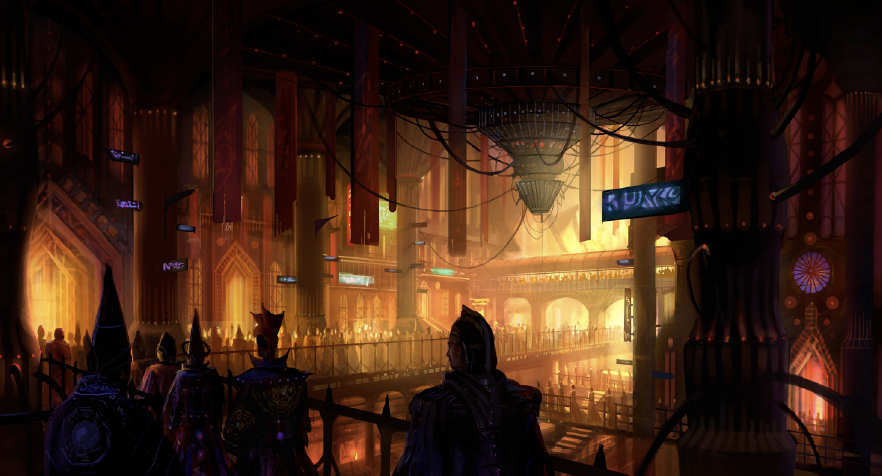
The other unusual aspect of this game is the almost hyper-narrative bent to it. The questions above don’t have answers that are represented in character mechanics. There are no hit points. No talents or feats. No classes or careers. Each character is name/a job/a power in the world of GHOST/ECHO. When do they die? When the story consequences lead to that.
The resolution mechanics are very simple, but also very unique. The game details when you roll, and a player rolls a 6-sided die for each goal and danger they face in the situation. The Goal + Danger schema is the heart of the game. Depending on what the player wants to do, they describe their goal (e.g.: Commit Murder, Sneak about Undetected, etc.) and the GM describes the associated danger (e.g: Commit Murder + Unwanted Harm, Sneak about Undetected + You are Caught in the Act, etc.)
The point is, a goal (the reason you’re rolling) is always going to come with at least one danger; so, 2 dice, minimum, for any roll you make. But making a single roll with multiple dangers is entirely possible, if the GM feels this goal has multiple dangers, and each will grant it’s own d6. Players may also get to roll 1 extra d6 if they’re especially well-prepared for the situation, and a player may even choose to add an extra danger to the roll, just to get another d6. Of course… they still have to resolve ALL of the dangers. After rolling, the player then selects which d6 result to assign to each goal and each danger. This is important, because each roll result (1-2, 3-4, 5-6) has a different outcome on the completion of the goal, or the enforcement of the danger. It’s entirely possible to fail at the goal, but still not have the danger come to pass. Or to achieve the goal (fully or partially), and still have to deal with the danger. The danger might even be partially realized, but it then sticks with you to be later added to another roll. It all depends on how the player chooses to assign their die results.
This dual-axis of resolution is extremely rewarding, but remains simple (accomplished only with d6s) and puts all the power into the player’s hands. Furthermore, aside from being “especially well prepared”, there are no character or other situational modifications to the dice. The player’s only real option is to make things MORE dangerous, in order to give themselves a bigger dice pool, and a bigger change of accomplishing their goal (all at the risk of dealing with a myriad of nasty dangers).
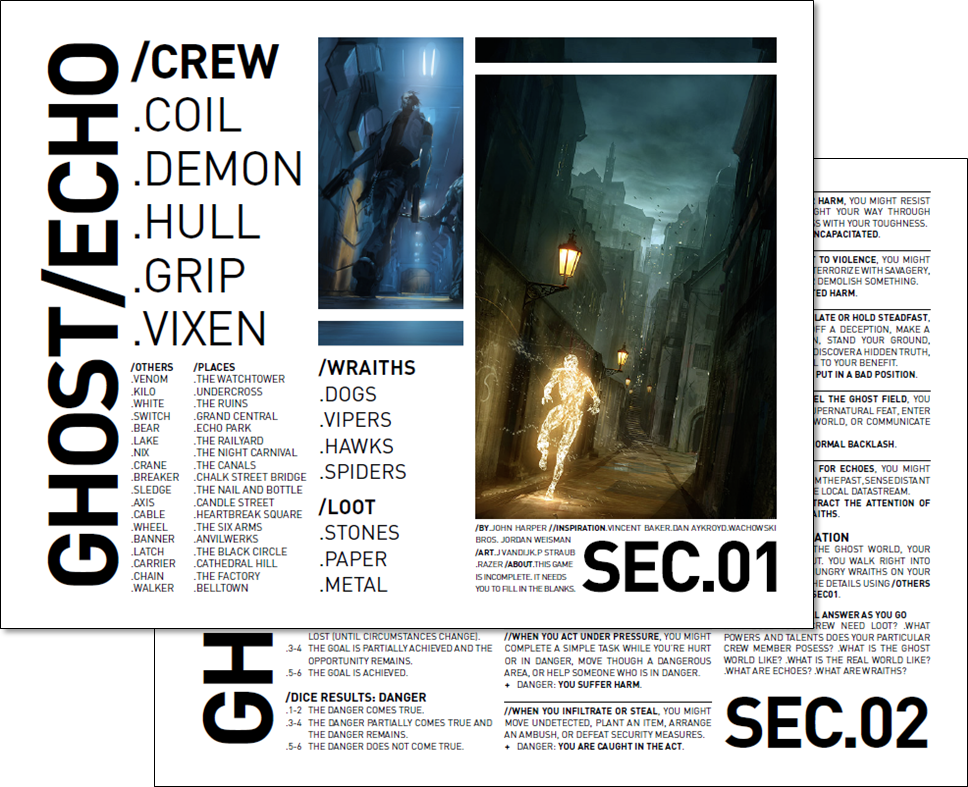
The system mechanics are – in a word – elegant. Frankly, these resolution mechanics would be right at home in a system with a complex, fully fleshed out setting. But, as I’ve said, the brilliance of GHOST/ECHO isn’t in the mechanics – it’s the “Oracle Game” design. Trust me. From concept to mechanics – you’ve never played anything like this.
When I finally got GHOST/ECHO on the table (after literal years of being afraid of it), I found a game that was utterly enjoyable. My players and I crafted a world around these seeds in about 20 minutes, and then proceeded to search for “echoes” into the “ghost world” and take on a daring job that boosted their “Paper” and “Metal”. What does all that mean? That… I leave up to you and your own group.
I think that true narrative roleplaying (which has become such a passion for me in the past few years) is more than player/GM narration of action and outcome. It’s a narration – by the players – of the world. Working with a strong GM to craft a gaming memory, that’s what GHOST/ECHO is about. At it’s heart. At it’s core.
So go download GHOST/ECHO already. It’s free. And if it actually did cost money – I’d still advise you to pay for it.
Peace, Love, and Good Gaming – GMC
(All names, references, and pictures presented in this article were created by One Seven Design and are publicly available at http://onesevendesign.com. GHOST/ECHO is licensed under Creative Commons (CC BY-NC-SA 3.0) License, all rights reserved by their respective owners. This article is a media work of review and publicity, and is in no way intended to share intellectual property or copyrighted material outside the scope of media review.)
